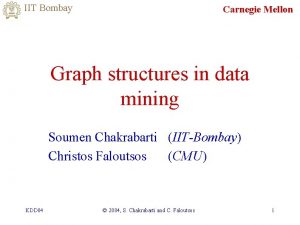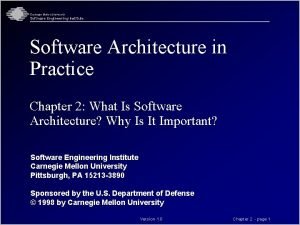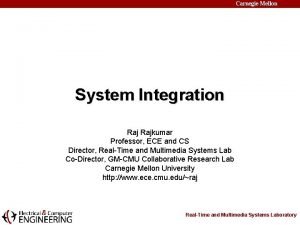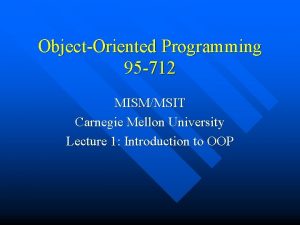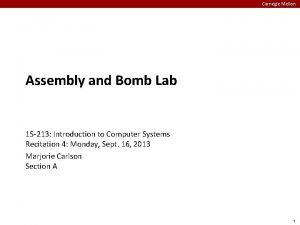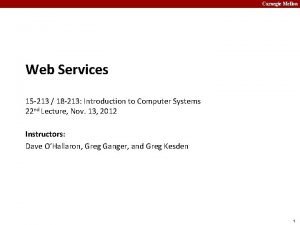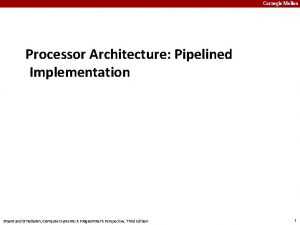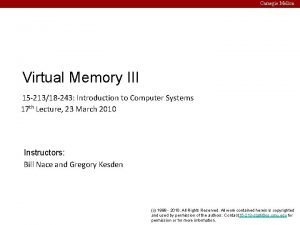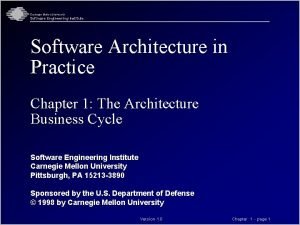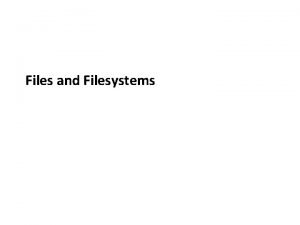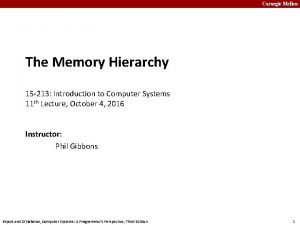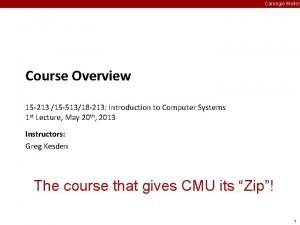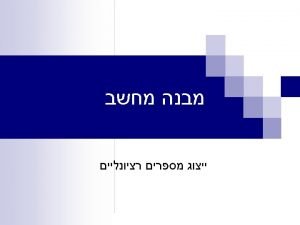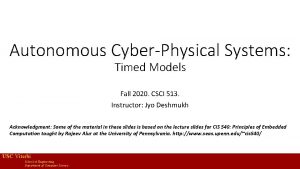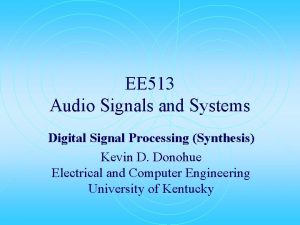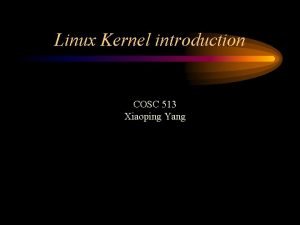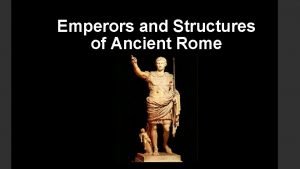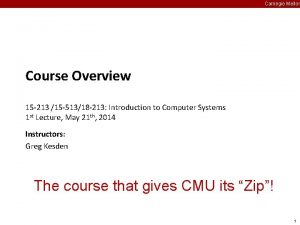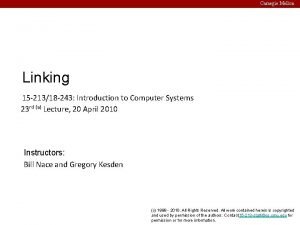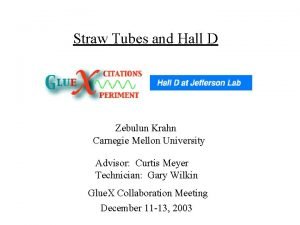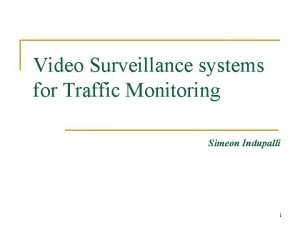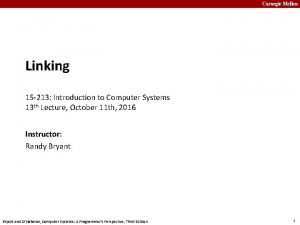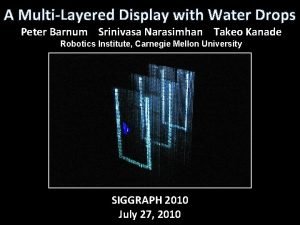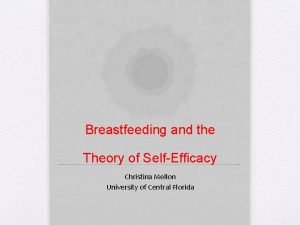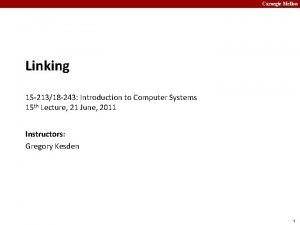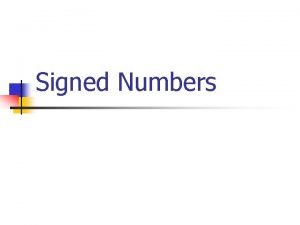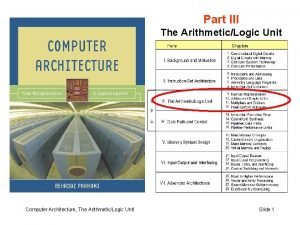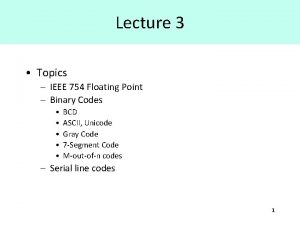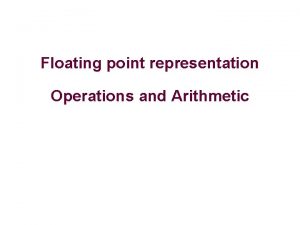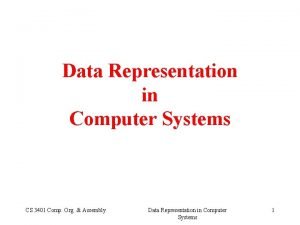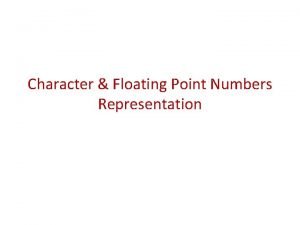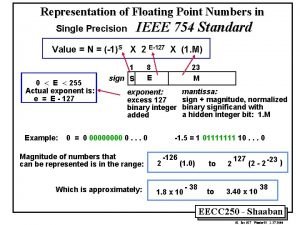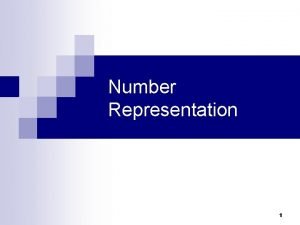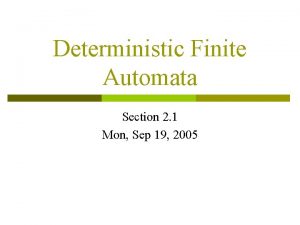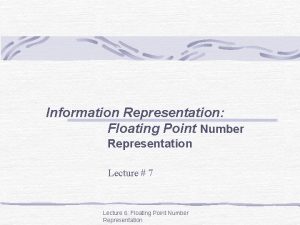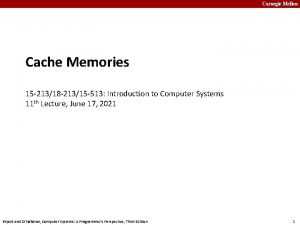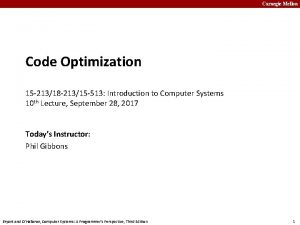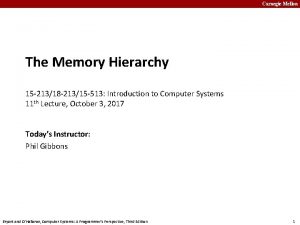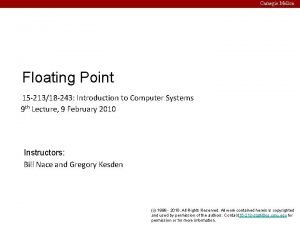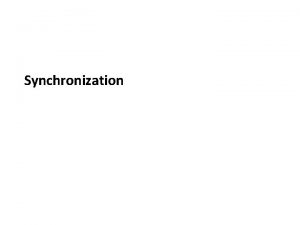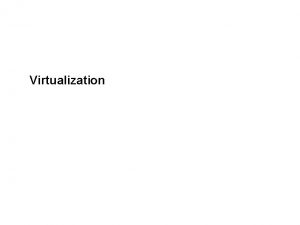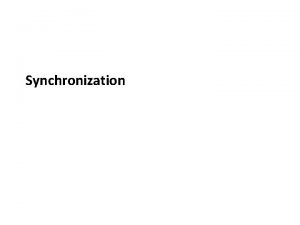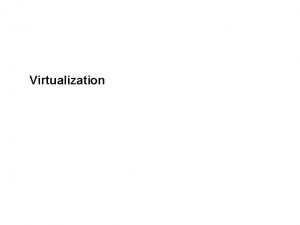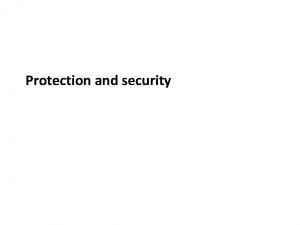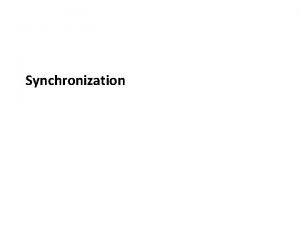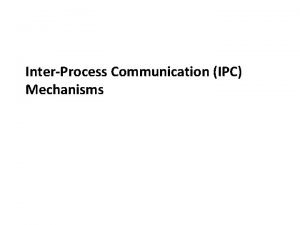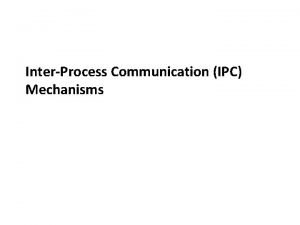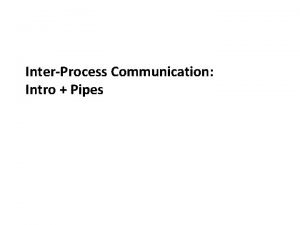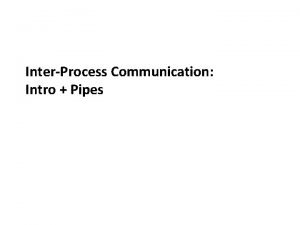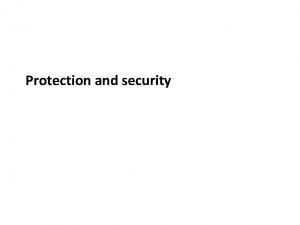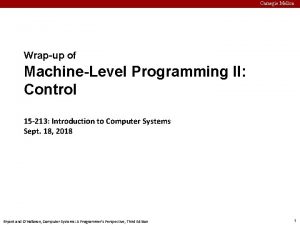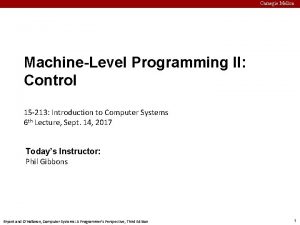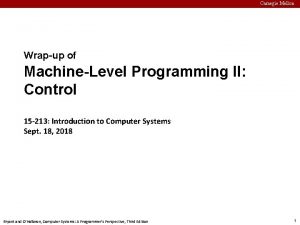Carnegie Mellon Floating Point 15 21318 21315 513
















































- Slides: 48

Carnegie Mellon Floating Point 15 -213/18 -213/15 -513: Introduction to Computer Systems 4 th Lecture, June 1, 2021 Bryant and O’Hallaron, Computer Systems: A Programmer’s Perspective, Third Edition

Carnegie Mellon Today: Floating Point ¢ ¢ ¢ Background: Fractional binary numbers IEEE floating point standard: Definition Example and properties Rounding, addition, multiplication Floating point in C Summary Bryant and O’Hallaron, Computer Systems: A Programmer’s Perspective, Third Edition 2

Carnegie Mellon Fractional binary numbers ¢ What is 1011. 1012? Bryant and O’Hallaron, Computer Systems: A Programmer’s Perspective, Third Edition 3

Carnegie Mellon Fractional Binary Numbers 2 i 2 i-1 4 2 1 • • • bi bi-1 • • • b 2 b 1 b 0 b-1 b-2 b-3 • • • b-j ¢ Representation • • • 1/2 1/4 1/8 2 -j § Bits to right of “binary point” represent fractional powers of 2 § Represents rational number: Bryant and O’Hallaron, Computer Systems: A Programmer’s Perspective, Third Edition 4

Carnegie Mellon Fractional Binary Numbers: Examples ¢ ¢ Value Representation 5 3/4 = 23/4 2 7/8 = 23/8 1 7/16 = 23/16 101. 112 010. 1112 001. 01112 = 4 + 1/2 + 1/4 = 2 + 1/4 + 1/8 = 1 + 1/4 + 1/8 + 1/16 Observations § Divide by 2 by shifting right (unsigned) § Multiply by 2 by shifting left § Numbers of form 0. 111111… 2 are just below 1. 0 1/2 + 1/4 + 1/8 + … + 1/2 i + … ➙ 1. 0 § Use notation 1. 0 – ε § Bryant and O’Hallaron, Computer Systems: A Programmer’s Perspective, Third Edition 5

Carnegie Mellon Representable Numbers ¢ Limitation #1 § Can only exactly represent numbers of the form x/2 k § Other rational numbers have repeating bit representations § Value 1/3 § 1/5 § 1/10 § ¢ Representation 0. 010101[01]… 2 0. 00110011[0011]… 2 0. 000110011[0011]… 2 Limitation #2 § Just one setting of binary point within the w bits § Limited range of numbers (very small values? very large? ) Bryant and O’Hallaron, Computer Systems: A Programmer’s Perspective, Third Edition 6

Carnegie Mellon Today: Floating Point ¢ ¢ ¢ Background: Fractional binary numbers IEEE floating point standard: Definition Example and properties Rounding, addition, multiplication Floating point in C Summary Bryant and O’Hallaron, Computer Systems: A Programmer’s Perspective, Third Edition 7

Carnegie Mellon IEEE Floating Point ¢ IEEE Standard 754 § Established in 1985 as uniform standard for floating point arithmetic Before that, many idiosyncratic formats § Supported by all major CPUs § Some CPUs don’t implement IEEE 754 in full e. g. , early GPUs, Cell BE processor § ¢ Driven by numerical concerns § Nice standards for rounding, overflow, underflow § Hard to make fast in hardware § Numerical analysts predominated over hardware designers in defining standard Bryant and O’Hallaron, Computer Systems: A Programmer’s Perspective, Third Edition 8

Carnegie Mellon This is important! ¢ Ariane 5 explodes on maiden voyage: $500 MILLION dollars lost § 64 -bit floating point number assigned to 16 -bit integer § Causes rocket to get incorrect value of horizontal velocity and crash ¢ Patriot Missile defense system misses scud – 28 people die § § System tracks time in tenths of second Converted from integer to floating point number. Accumulated rounding error causes drift. 20% drift over 8 hours. Eventually (on 2/25/1991 system was on for 100 hours) causes range misestimation sufficiently large to miss incoming missiles. Bryant and O’Hallaron, Computer Systems: A Programmer’s Perspective, Third Edition 9

Carnegie Mellon Floating Point Representation ¢ Numerical Form: (– 1)s M 2 E Example: 1521310 = (-1)0 x 1. 11011012 x 213 § Sign bit s determines whether number is negative or positive § Significand M normally a fractional value in range [1. 0, 2. 0). § Exponent E weights value by power of two ¢ Encoding § MSB s is sign bit s § exp field encodes E (but is not equal to E) § frac field encodes M (but is not equal to M) s exp frac Bryant and O’Hallaron, Computer Systems: A Programmer’s Perspective, Third Edition 10

Carnegie Mellon Precision options ¢ Single precision: 32 bits 7 decimal digits, 10± 38 s exp 1 ¢ frac 8 -bits Double precision: 64 bits 16 decimal digits, 10± 308 s exp 1 ¢ 23 -bits frac 11 -bits 52 -bits Other formats: half precision, quad precision Bryant and O’Hallaron, Computer Systems: A Programmer’s Perspective, Third Edition 11

Carnegie Mellon Three “kinds” of floating point numbers s exp 1 frac e-bits f-bits 00… 00 exp ≠ 0 and exp ≠ 11… 11 denormalized special Bryant and O’Hallaron, Computer Systems: A Programmer’s Perspective, Third Edition 12

Carnegie Mellon “Normalized” Values v = (– 1)s M 2 E ¢ When: exp ≠ 000… 0 and exp ≠ 111… 1 ¢ Exponent coded as a biased value: E = exp – Bias § exp: unsigned value of exp field § Bias = 2 k-1 - 1, where k is number of exponent bits Single precision: 127 (exp: 1… 254, E: -126… 127) § Double precision: 1023 (exp: 1… 2046, E: -1022… 1023) § ¢ Significand coded with implied leading 1: M = 1. xxx…x 2 § § xxx…x: bits of frac field Minimum when frac=000… 0 (M = 1. 0) Maximum when frac=111… 1 (M = 2. 0 – ε) Get extra leading bit for “free” Bryant and O’Hallaron, Computer Systems: A Programmer’s Perspective, Third Edition 13

Carnegie Mellon Normalized Encoding Example ¢ v = (– 1)s M 2 E E = exp – Bias Value: float F = 15213. 0; § 1521310 = 111011012 = 1. 11011012 x 213 ¢ Significand M = frac = ¢ 1. 11011012 1101101000002 Exponent E = Bias = exp = ¢ 13 127 140 = 100011002 Result: 0 10001100 110110100000 s exp Bryant and O’Hallaron, Computer Systems: A Programmer’s Perspective, Third Edition frac 14

Carnegie Mellon Denormalized Values ¢ ¢ ¢ v = (– 1)s M 2 E E = 1 – Bias Condition: exp = 000… 0 Exponent value: E = 1 – Bias (instead of exp – Bias) (why? ) Significand coded with implied leading 0: M = 0. xxx…x 2 § xxx…x: bits of frac ¢ Cases § exp = 000… 0, frac = 000… 0 Represents zero value § Note distinct values: +0 and – 0 (why? ) § exp = 000… 0, frac ≠ 000… 0 § Numbers closest to 0. 0 § Equispaced § Bryant and O’Hallaron, Computer Systems: A Programmer’s Perspective, Third Edition 15

Carnegie Mellon Special Values ¢ Condition: exp = 111… 1 ¢ Case: exp = 111… 1, frac = 000… 0 § § ¢ Represents value (infinity) Operation that overflows Both positive and negative E. g. , 1. 0/0. 0 = − 1. 0/− 0. 0 = + , 1. 0/− 0. 0 = − Case: exp = 111… 1, frac ≠ 000… 0 § Not-a-Number (Na. N) § Represents case when no numeric value can be determined § E. g. , sqrt(– 1), − , 0 Bryant and O’Hallaron, Computer Systems: A Programmer’s Perspective, Third Edition 16

Carnegie Mellon C float Decoding Example float: 0 x. C 0 A 00000 Bias = 2 k-1 – 1 = 127 binary: 1 8 -bits v = (– 1)s M 2 E E = exp – Bias 23 -bits E = 129 S = 1 -> negative number M = 1. 010 0000 0000 M = 1 + 1/4 = 1. 25 v = (– 1)s M 2 E = Bryant and O’Hallaron, Computer Systems: A Programmer’s Perspective, Third Edition 17

Carnegie Mellon C float Decoding Example #1 float: 0 x. C 0 A 00000 v = (– 1)s M 2 E E = exp – Bias binary: 1100 0000 1010 0000 0000 1 1000 0001 1 010 0000 0000 8 -bits 23 -bits E = 129 S = 1 -> negative number M = 1. 010 0000 0000 M = 1 + 1/4 = 1. 25 v = (– 1)s M 2 E = Bryant and O’Hallaron, Computer Systems: A Programmer’s Perspective, Third Edition 18

Carnegie Mellon C float Decoding Example #1 float: 0 x. C 0 A 00000 binary: 1100 0000 1010 0000 1 1000 0001 1 v = (– 1)s M 2 E E = exp – Bias = 2 k-1 – 1 = 0000 127 0000 010 0000 0000 8 -bits 23 -bits E = exp – Bias = 129 – 127 = 2 (decimal) S = 1 -> negative number M = 1. 010 0000 0000 M = 1 + 1/4 = 1. 25 v = (– 1)s M 2 E = (-1)1 * 1. 25 * 22 = -5 Bryant and O’Hallaron, Computer Systems: A Programmer’s Perspective, Third Edition 19

Carnegie Mellon C float Decoding Example #2 float: 0 x 001 C 0000 v = (– 1)s M 2 E E = 1 – Bias binary: 0000 0001 1100 0000 0 0000 1 001 1100 0000 8 -bits 23 -bits E = 129 S = 1 -> negative number M = 0. 010 0000 0000 M = 1 + 1/4 = 1. 25 v = (– 1)s M 2 E = Bryant and O’Hallaron, Computer Systems: A Programmer’s Perspective, Third Edition 20

Carnegie Mellon C float Decoding Example #2 float: 0 x 001 C 0000 binary: 0000 0001 1100 0000 1 v = (– 1)s M 2 E E = 1 – Bias = 2 k-1 – 1 = 0000 127 0000 001 1100 0000 8 -bits 23 -bits E = 1 – Bias = 1 – 127 = – 126 (decimal) S = 0 -> positive number M = 0. 001 1100 0000 M = 1/8 + 1/16 + 1/32 = 7*2– 5 v = (– 1)s M 2 E = (-1)0 * 7*2– 5 * 2– 126 = 7*2– 131 v ≈ 2. 571393892 X 10– 39 Bryant and O’Hallaron, Computer Systems: A Programmer’s Perspective, Third Edition 21

Carnegie Mellon Visualization: Floating Point Encodings − Na. N −Normalized −Denorm 0 Bryant and O’Hallaron, Computer Systems: A Programmer’s Perspective, Third Edition +Denorm +0 +Normalized + Na. N 22

Carnegie Mellon Today: Floating Point ¢ ¢ ¢ Background: Fractional binary numbers IEEE floating point standard: Definition Example and properties Rounding, addition, multiplication Floating point in C Summary Bryant and O’Hallaron, Computer Systems: A Programmer’s Perspective, Third Edition 23

Carnegie Mellon Tiny Floating Point Example ¢ s exp frac 1 4 -bits 3 -bits 8 -bit Floating Point Representation § the sign bit is in the most significant bit § the next four bits are the exp, with a bias of 7 § the last three bits are the frac ¢ Same general form as IEEE Format § normalized, denormalized § representation of 0, Na. N, infinity Bryant and O’Hallaron, Computer Systems: A Programmer’s Perspective, Third Edition 24

Carnegie Mellon Dynamic Range (s=0 only) s exp 0 0 Denormalized 0 … numbers 0 0 … 0 0 0 Normalized numbers 0 0 … 0 0 0 frac E Value 0000 001 0000 010 -6 -6 -6 0 1/8*1/64 = 1/512 2/8*1/64 = 2/512 0000 0001 110 111 000 001 -6 -6 6/8*1/64 7/8*1/64 8/8*1/64 9/8*1/64 = = 6/512 7/512 8/512 9/512 0110 0111 110 111 000 001 010 -1 -1 0 0 0 14/8*1/2 15/8*1/2 8/8*1 9/8*1 10/8*1 = = = 14/16 15/16 1 9/8 10/8 7 7 n/a 14/8*128 = 224 15/8*128 = 240 inf 1110 1111 000 Bryant and O’Hallaron, Computer Systems: A Programmer’s Perspective, Third Edition v = (– 1)s M 2 E norm: E = exp – Bias denorm: E=1– closest to zero -6 Bias (-1)0(0+1/4)*2 largest denorm smallest norm (-1)0(1+1/8)*2 -6 closest to 1 below closest to 1 above largest norm 25

Carnegie Mellon Distribution of Values ¢ 6 -bit IEEE-like format § e = 3 exponent bits § f = 2 fraction bits § Bias is 23 -1 -1 = 3 ¢ s exp frac 1 3 -bits 2 -bits Notice how the distribution gets denser toward zero. 8 values Bryant and O’Hallaron, Computer Systems: A Programmer’s Perspective, Third Edition 26

Carnegie Mellon Distribution of Values (close-up view) ¢ 6 -bit IEEE-like format § e = 3 exponent bits § f = 2 fraction bits § Bias is 3 s exp frac 1 3 -bits 2 -bits Bryant and O’Hallaron, Computer Systems: A Programmer’s Perspective, Third Edition 27

Carnegie Mellon Special Properties of the IEEE Encoding ¢ FP Zero Same as Integer Zero § All bits = 0 ¢ Can (Almost) Use Unsigned Integer Comparison § Must first compare sign bits § Must consider − 0 = 0 § Na. Ns problematic Will be greater than any other values § What should comparison yield? The answer is complicated. § Otherwise OK § Denorm vs. normalized § Normalized vs. infinity § Bryant and O’Hallaron, Computer Systems: A Programmer’s Perspective, Third Edition 28

Carnegie Mellon Quiz Time! Check out: https: //canvas. cmu. edu/courses/16836 Bryant and O’Hallaron, Computer Systems: A Programmer’s Perspective, Third Edition 29

Carnegie Mellon Today: Floating Point ¢ ¢ ¢ Background: Fractional binary numbers IEEE floating point standard: Definition Example and properties Rounding, addition, multiplication Floating point in C Summary Bryant and O’Hallaron, Computer Systems: A Programmer’s Perspective, Third Edition 30

Carnegie Mellon Floating Point Operations: Basic Idea ¢ x +f y = Round(x + y) ¢ x f y = Round(x y) ¢ Basic idea § First compute exact result § Make it fit into desired precision Possibly overflow if exponent too large § Possibly round to fit into frac § Bryant and O’Hallaron, Computer Systems: A Programmer’s Perspective, Third Edition 31

Carnegie Mellon Rounding ¢ Rounding Modes (illustrate with $ rounding) $1. 40 $1. 60 $1. 50 $2. 50 –$1. 50 § § Towards zero Round down (− ) Round up (+ ) Nearest Even* (default) $1 $1 $2 $1 $1 $1 $2 $2 $3 $2 –$1 –$2 *Round to nearest, but if half-way in-between then round to nearest even Bryant and O’Hallaron, Computer Systems: A Programmer’s Perspective, Third Edition 32

Carnegie Mellon Closer Look at Round-To-Even ¢ Default Rounding Mode § Hard to get any other kind without dropping into assembly C 99 has support for rounding mode management § All others are statistically biased § Sum of set of positive numbers will consistently be over- or underestimated § ¢ Applying to Other Decimal Places / Bit Positions § When exactly halfway between two possible values Round so that least significant digit is even § E. g. , round to nearest hundredth 7. 8949999 7. 89 (Less than half way) 7. 8950001 7. 90 (Greater than half way) 7. 8950000 7. 90 (Half way—round up) 7. 8850000 7. 88 (Half way—round down) § Bryant and O’Hallaron, Computer Systems: A Programmer’s Perspective, Third Edition 33

Carnegie Mellon Rounding Binary Numbers ¢ Binary Fractional Numbers § “Even” when least significant bit is 0 § “Half way” when bits to right of rounding position = 100… 2 ¢ Examples § Round to nearest 1/4 (2 bits right of binary point) Value 2 3/32 2 3/16 2 7/8 2 5/8 Binary 10. 000112 10. 001102 10. 111002 10. 101002 Rounded 10. 002 10. 012 11. 002 10. 102 Bryant and O’Hallaron, Computer Systems: A Programmer’s Perspective, Third Edition Action (<1/2—down) (>1/2—up) ( 1/2—down) Rounded Value 2 2 1/4 3 2 1/2 34

Carnegie Mellon Rounding 1. BBGRXXX Guard bit: LSB of result Round bit: 1 st bit removed ¢ Sticky bit: OR of remaining bits Round up conditions § Round = 1, Sticky = 1 ➙ > 0. 5 § Guard = 1, Round = 1, Sticky = 0 ➙ Round to even Fraction 1. 0000000 1. 1010000 1. 0001000 1. 0011000 1. 0001010 1. 1111100 GRS 000 100 010 110 011 111 Incr? Rounded N N N Y Y Y Bryant and O’Hallaron, Computer Systems: A Programmer’s Perspective, Third Edition 1. 000 1. 101 1. 000 1. 010 1. 001 10. 000 35

Carnegie Mellon FP Multiplication ¢ ¢ (– 1)s 1 M 1 2 E 1 x (– 1)s 2 M 2 2 E 2 Exact Result: (– 1)s M 2 E § Sign s: § Significand M: § Exponent E: ¢ s 1 ^ s 2 M 1 x M 2 E 1 + E 2 Fixing § If M ≥ 2, shift M right, increment E § If E out of range, overflow § Round M to fit frac precision ¢ Implementation § Biggest chore is multiplying significands 4 bit significand: 1. 010*22 x 1. 110*23 = 10. 0011*25 = 1. 00011*26 = 1. 001*26 Bryant and O’Hallaron, Computer Systems: A Programmer’s Perspective, Third Edition 36

Carnegie Mellon Floating Point Addition ¢ (– 1)s 1 M 1 2 E 1 + (-1)s 2 M 2 2 E 2 §Assume E 1 > E 2 ¢ Get binary points lined up Exact Result: (– 1)s M 2 E E 1–E 2 §Sign s, significand M: Result of signed align & add §Exponent E: E 1 § ¢ Fixing (– 1)s 1 M 1 + §If M ≥ 2, shift M right, increment E §if M < 1, shift M left k positions, decrement E by k §Overflow if E out of range §Round M to fit frac precision (– 1)s 2 M 2 (– 1)s M 1. 010*22 + 1. 110*23 = (0. 1010 + 1. 1100)*23 = 10. 0110 * 23 = 1. 00110 * 24 = 1. 010 * 24 Bryant and O’Hallaron, Computer Systems: A Programmer’s Perspective, Third Edition 37

Carnegie Mellon Mathematical Properties of FP Add ¢ Compare to those of Abelian Group § Closed under addition? Yes But may generate infinity or Na. N § Commutative? Yes § Associative? No § Overflow and inexactness of rounding § (3. 14+1 e 10)-1 e 10 = 0, 3. 14+(1 e 10 -1 e 10) = 3. 14 § § 0 is additive identity? § Every element has additive inverse? § ¢ Yes Almost Yes, except for infinities & Na. Ns Monotonicity § a ≥ b ⇒ a+c ≥ b+c? § Almost Except for infinities & Na. Ns Bryant and O’Hallaron, Computer Systems: A Programmer’s Perspective, Third Edition 38

Carnegie Mellon Mathematical Properties of FP Mult ¢ Compare to Commutative Ring § Closed under multiplication? Yes But may generate infinity or Na. N § Multiplication Commutative? Yes § Multiplication is Associative? No § Possibility of overflow, inexactness of rounding § Ex: (1 e 20*1 e 20)*1 e-20= inf, 1 e 20*(1 e 20*1 e-20)= 1 e 20 § § 1 is multiplicative identity? § Multiplication distributes over addition? Yes No Possibility of overflow, inexactness of rounding § 1 e 20*(1 e 20 -1 e 20)= 0. 0, 1 e 20*1 e 20 – 1 e 20*1 e 20 = Na. N § ¢ Monotonicity § a ≥ b & c ≥ 0 ⇒ a * c ≥ b *c? § Almost Except for infinities & Na. Ns Bryant and O’Hallaron, Computer Systems: A Programmer’s Perspective, Third Edition 39

Carnegie Mellon Today: Floating Point ¢ ¢ ¢ Background: Fractional binary numbers IEEE floating point standard: Definition Example and properties Rounding, addition, multiplication Floating point in C Summary Bryant and O’Hallaron, Computer Systems: A Programmer’s Perspective, Third Edition 40

Carnegie Mellon Floating Point in C ¢ C Guarantees Two Levels § float § double ¢ single precision double precision Conversions/Casting § Casting between int, float, and double changes bit representation § double/float → int Truncates fractional part § Like rounding toward zero § Not defined when out of range or Na. N: Generally sets to TMin § int → double § Exact conversion, as long as int has ≤ 53 bit word size § int → float § Will round according to rounding mode § Bryant and O’Hallaron, Computer Systems: A Programmer’s Perspective, Third Edition 41

Carnegie Mellon Floating Point Puzzles ¢ For each of the following C expressions, either: § Argue that it is true for all argument values § Explain why not true int x = …; float f = …; double d = …; Assume neither d nor f is Na. N • • • x == (int)(float) x x == (int)(double) x f == (float)(double) f d == (double)(float) d f == -(-f); 2/3 == 2/3. 0 d < 0. 0 ⇒ ((d*2) < 0. 0) d > f ⇒ -f > -d d * d >= 0. 0 (d+f)-d == f Bryant and O’Hallaron, Computer Systems: A Programmer’s Perspective, Third Edition 42

Carnegie Mellon Summary ¢ ¢ ¢ IEEE Floating Point has clear mathematical properties Represents numbers of form M x 2 E One can reason about operations independent of implementation § As if computed with perfect precision and then rounded ¢ Not the same as real arithmetic § Violates associativity/distributivity § Makes life difficult for compilers & serious numerical applications programmers Bryant and O’Hallaron, Computer Systems: A Programmer’s Perspective, Third Edition 43

Carnegie Mellon Additional Slides Bryant and O’Hallaron, Computer Systems: A Programmer’s Perspective, Third Edition 44

Carnegie Mellon Creating Floating Point Number ¢ Steps s exp § Normalize to have leading 1 1 4 -bits § Round to fit within fraction § Postnormalize to deal with effects of rounding ¢ frac 3 -bits Case Study § Convert 8 -bit unsigned numbers to tiny floating point format Example Numbers 128 15 33 35 138 63 100000001101 00010011 10001010 00111111 Bryant and O’Hallaron, Computer Systems: A Programmer’s Perspective, Third Edition 45

Carnegie Mellon Normalize ¢ Requirement s exp frac 1 4 -bits 3 -bits § Set binary point so that numbers of form 1. xxxxx § Adjust all to have leading one Decrement exponent as shift left Value Binary Fraction 128 10000000 15 00001101 1. 1010000 17 0001 1. 0001000 19 00010011 1. 0011000 138 10001010 1. 0001010 63 00111111 1. 1111100 § Bryant and O’Hallaron, Computer Systems: A Programmer’s Perspective, Third Edition Exponent 7 3 4 4 7 5 46

Carnegie Mellon Postnormalize ¢ Issue § Rounding may have caused overflow § Handle by shifting right once & incrementing exponent Value 128 15 17 19 138 63 Rounded 1. 000 1. 101 1. 000 1. 010 1. 001 10. 000 Exp 7 3 4 4 7 5 Bryant and O’Hallaron, Computer Systems: A Programmer’s Perspective, Third Edition Adjusted 1. 000/6 Numeric Result 128 15 16 20 134 64 47

Carnegie Mellon Interesting Numbers {single, double} Description ¢ Zero exp frac 00… 00 Numeric Value 0. 0 Smallest Pos. Denorm. § Single ≈ 1. 4 x 10– 45 § Double ≈ 4. 9 x 10– 324 00… 00 00… 01 2– {23, 52} x 2– {126, 1022} Largest Denormalized § Single ≈ 1. 18 x 10– 38 § Double ≈ 2. 2 x 10– 308 00… 00 11… 11 (1. 0 – ε) x 2– {126, 1022} ¢ ¢ ¢ Smallest Pos. Normalized 00… 01 00… 00 § Just larger than largest denormalized 1. 0 x 2– {126, 1022} One Largest Normalized § Single ≈ 3. 4 x 1038 § Double ≈ 1. 8 x 10308 1. 0 (2. 0 – ε) x 2{127, 1023} 01… 11 00… 00 11… 11 Bryant and O’Hallaron, Computer Systems: A Programmer’s Perspective, Third Edition 48
 Iit
Iit Carnegie mellon software architecture
Carnegie mellon software architecture Carnegie mellon
Carnegie mellon Cmu mism
Cmu mism Cmu bomb lab
Cmu bomb lab Carnegie mellon
Carnegie mellon Bomb lab secret phase
Bomb lab secret phase Frax
Frax Carnegie mellon
Carnegie mellon Randy pausch carnegie mellon
Randy pausch carnegie mellon Cmu pitt computational biology
Cmu pitt computational biology Carnegie mellon vpn
Carnegie mellon vpn Carnegie mellon software architecture
Carnegie mellon software architecture Carnegie mellon fat letter
Carnegie mellon fat letter Kevin thompson nsf
Kevin thompson nsf Carnegie mellon interdisciplinary
Carnegie mellon interdisciplinary Carnegie mellon
Carnegie mellon Carnegie mellon university research participants
Carnegie mellon university research participants Cmu 15-513
Cmu 15-513 Fixed point vs floating point
Fixed point vs floating point Csci 513 usc
Csci 513 usc Ee-513
Ee-513 Linux 513
Linux 513 Upc 2-513
Upc 2-513 Ee-513
Ee-513 Julius caesar buildings
Julius caesar buildings 15-513 cmu
15-513 cmu Ee-513
Ee-513 Mellon serbia iskustva
Mellon serbia iskustva Bny mellon health savings account
Bny mellon health savings account Mellon elf
Mellon elf Mellon tubes
Mellon tubes Carneigh mellon
Carneigh mellon Mellon elf
Mellon elf Water mellon
Water mellon Conclusion of breastfeeding
Conclusion of breastfeeding Mellon elf
Mellon elf Range of signed number
Range of signed number 4 bit two's complement
4 bit two's complement Floating point puzzles
Floating point puzzles Xkcd floating point
Xkcd floating point Floating point
Floating point Floating point arithmetic
Floating point arithmetic Express (32)10 in the revised 14-bit floating-point model
Express (32)10 in the revised 14-bit floating-point model Eascii
Eascii Floating point multiplication flowchart
Floating point multiplication flowchart Number system
Number system Dfa for floating point numbers
Dfa for floating point numbers Floating point number system
Floating point number system
